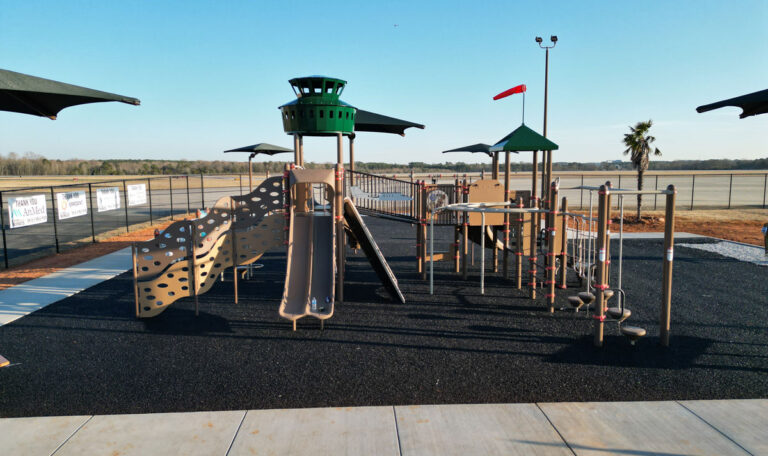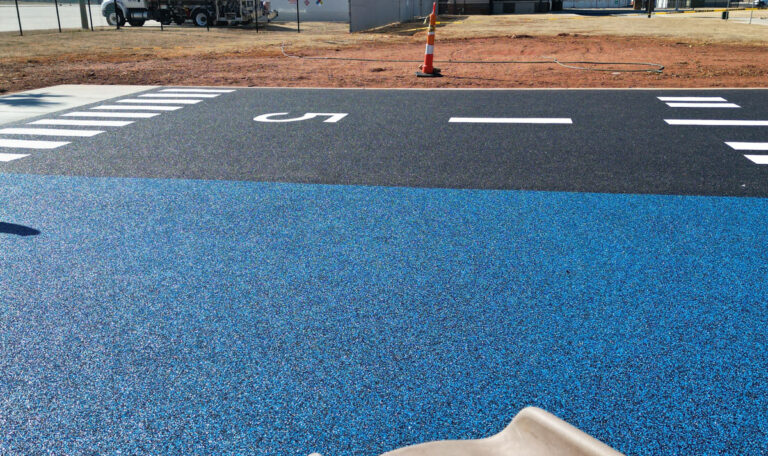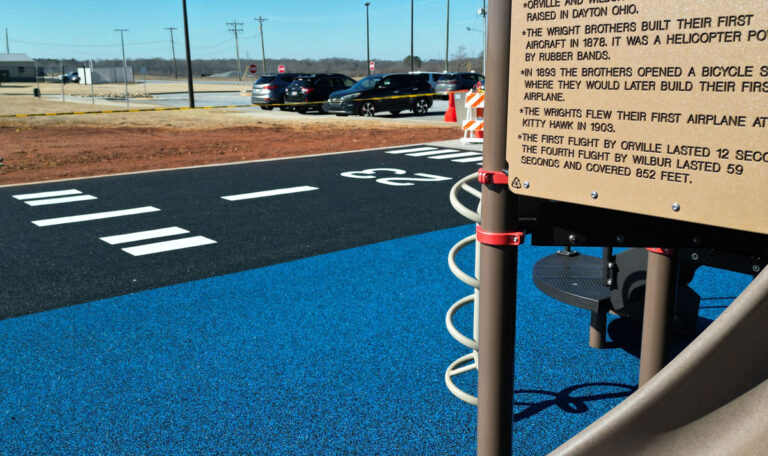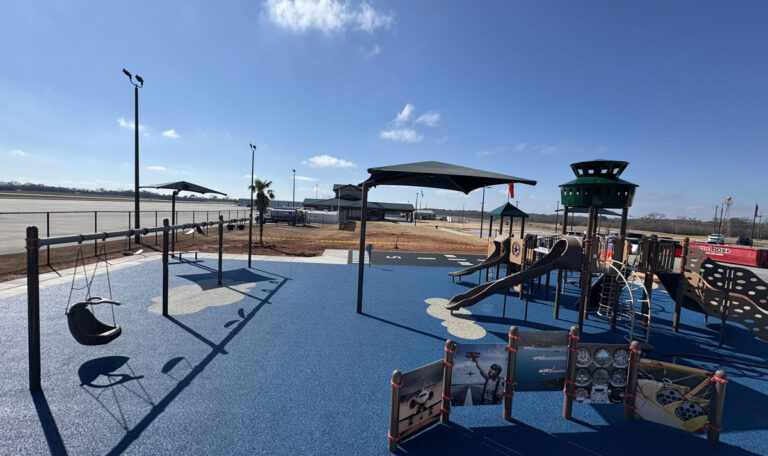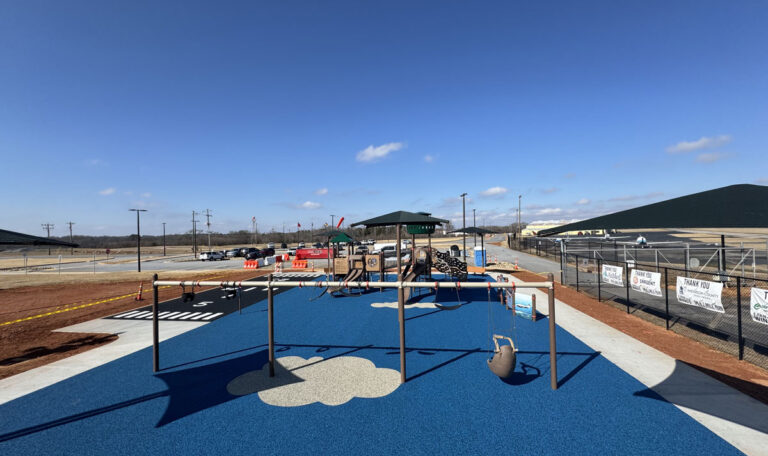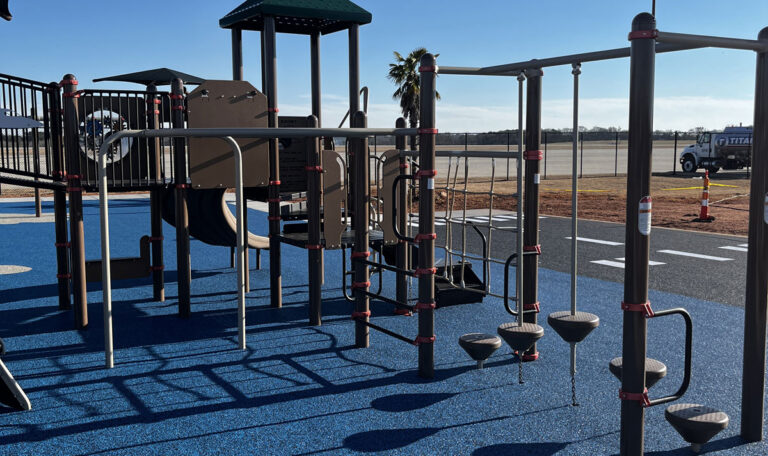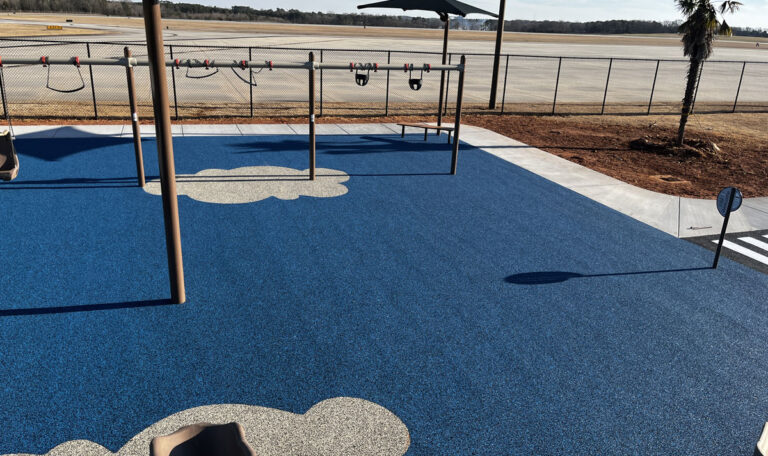Creating Safe, Sustainable Play Spaces with Recycled Materials
Recycled tire playground flooring is a durable, shock-absorbing surface made from processed used tires that provides exceptional safety for children while supporting environmental sustainability. For facility managers looking for playground surfacing solutions, here’s what you need to know:
- Safety Rating: Protects falls from heights of 4-14 feet depending on thickness and type
- Lifespan: 12-15 years (compared to 1-2 years for wood mulch)
- Maintenance: Minimal – occasional sweeping and rinsing
- Environmental Impact: Diverts approximately 290 million scrap tires annually from landfills
- Types Available: Interlocking tiles, poured-in-place surfaces, bonded rubber mulch, loose-fill rubber mulch
When children race across a playground, their safety depends on what’s beneath their feet. Traditional surfaces like wood mulch, sand, or grass offer limited protection and require frequent maintenance. In contrast, recycled rubber surfacing transforms environmental waste into a superior playground solution.
The journey from discarded tire to playground surface is remarkable. Each year in the United States alone, about 290 million scrap tires enter the waste stream. Rather than taking hundreds of years to decompose in landfills, these tires can be collected, cleaned, and processed into various playground surfacing materials that meet rigorous safety standards.

Recycled tire playground flooring word guide:
– rubber flooring for playgrounds
– rubber concrete
– rubberized deck coating
What Is Recycled Tire Playground Flooring?
Ever wondered what happens to all those old tires once they’re no longer road-worthy? Recycled tire playground flooring gives these discarded tires a meaningful second life as safe, cushioned surfaces where children play. At Replay Surfacing, we’ve transformed over 100 million pounds of tires in just the past five years, keeping them out of landfills while creating something valuable for communities.
The magic starts with “crumb rubber” – essentially tire rubber that’s been processed into small particles. Depending on the specific playground application, these particles might range from fine powder to chunkier nuggets. This recycling process uses significantly less energy compared to manufacturing brand-new materials from scratch.
You might wonder about the safety of using old tires where children play. The EPA has conducted comprehensive studies on tire crumb constituents, examining both what’s in the rubber and how children might be exposed to it. While tires contain various chemicals, research shows that exposure levels during normal playground activities remain quite limited.
From Scrap Tire to Safety Surface
The journey from worn-out tire to colorful playground surface involves several fascinating steps. First comes collection and thorough cleaning to remove road grime and debris. Next, all steel wires and textile fibers that reinforce modern tires are removed and recycled separately.
The rubber then moves to the grinding phase, using either ambient grinding (mechanical shredding at room temperature) or cryogenic grinding (freezing rubber with liquid nitrogen for finer particles). To create vibrant playground surfaces, non-toxic, UV-resistant colorants are added. Finally, the rubber undergoes its final change – either being mixed with polyurethane binders for poured surfaces, formed into tiles, or processed into loose nuggets or bonded mulch.
Main Product Formats
Recycled tire playground flooring comes in four main varieties:
- Tiles: Pre-manufactured pieces typically measuring 2-3 inches thick that can be installed by interlocking or gluing down. Perfect for projects needing reliable, uniform fall protection with minimal installation time.
- Poured-in-place surfacing: Creates a seamless, custom playground surface on site by mixing rubber granules with polyurethane binder. Allows for incredible creativity – from game boards to colorful patterns.
- Bonded rubber: Offers a more natural aesthetic while maintaining superior durability. Similar to poured-in-place but using larger rubber pieces.
- Loose-fill mulch: Provides excellent fall protection without binding agents. These rubber nuggets are five times heavier than wood mulch, staying in place even during heavy rainstorms.
Types of Recycled Rubber Playground Surfaces
When choosing recycled tire playground flooring for your facility, understanding the different options helps you make the best choice for your specific needs, budget, and design vision.

At Replay Surfacing, we’ve installed all these surface types across our locations from Charlotte to Tucson, from Nashville to Beaverton. We’ve seen how each option performs in different climates and settings. For more details on our most popular option, check out our guide on Poured-in-Place Rubber.
Interlocking & Non-Toxic Tiles
Rubber tiles are the adaptable member of the recycled tire playground flooring family. These pre-made squares (typically 2 feet by 2 feet) come ready to install and range from 1-3 inches thick depending on your safety needs.
They connect with installation pins through an interlocking dowel system that holds everything securely in place. The edges of quality tiles are beveled to create smooth transitions, reducing trip hazards. This makes tiles perfect for both indoor and outdoor use – from daycare centers to rooftop play areas.
Depending on thickness, these tiles can protect children from falls of 4-7 feet. For those concerned about chemical safety, our guide on non-toxic playground tiles explains the testing and certification process.
Poured-in-Place Systems
Poured-in-place (PIP) surfaces are created right on site in two distinct layers. The base layer consists primarily of recycled SBR rubber from tires, providing crucial shock absorption. On top goes a layer of EPDM or TPV rubber that resists fading and stands up to UV exposure.
The magic of PIP systems lies in their flexibility. You can incorporate logos, educational elements, or games directly into the surface. Another advantage is the ability to adjust thickness in different areas based on equipment height.
The seamless installation eliminates trip hazards and creates an accessible surface for wheelchairs and mobility devices. Though the initial investment is higher than some alternatives, a properly installed PIP surface typically lasts 8-12 years.
Bonded & Loose-Fill Rubber Mulch
For playgrounds calling for a more natural look, rubber mulch brings the aesthetic of traditional wood mulch with improved performance and longevity.
Bonded rubber mulch takes rubber nuggets and binds them together with polyurethane, creating a contained surface that stays put. It offers excellent drainage while maintaining consistent fall protection.
Loose-fill rubber mulch consists of individual rubber nuggets installed at depths of 3-6 inches. This option provides remarkable fall protection – up to 14 feet when installed at six-inch depth. It’s about five times heavier than wood mulch, which means it stays in place during heavy rains.
For more information, see our guide on the advantages of playground rubber mulch.
Safety, Accessibility & Health Considerations
When kids climb, swing, and slide at the playground, what’s beneath their feet matters tremendously. Recycled tire playground flooring creates truly safe spaces where children can play with confidence.
Every surface meets or exceeds the rigorous ASTM F1292 standards for impact attenuation. When a child falls, these surfaces help cushion the impact to prevent serious injuries. The science behind playground safety comes down to key measurements like Critical Fall Height and Head Injury Criterion (HIC), which represent real protection for children.
Beyond cushioning falls, recycled tire playground flooring offers practical safety benefits. The non-slip surface stays grippy even after rain, unlike wood chips that can become slippery when wet. You’ll never find splinters in rubber surfacing, and it naturally resists insects and mold growth.

Certified Shock Absorption
The shock absorption capabilities of recycled tire playground flooring have been scientifically tested and certified. Different thicknesses provide different levels of protection: 2-inch rubber tiles typically protect falls up to 4-5 feet, while 3-inch tiles can handle falls up to 7 feet. Poured-in-place surfaces can be customized to different thicknesses, protecting children from falls between 4-12 feet. For maximum protection, 6 inches of rubber mulch can safeguard against falls up to 14 feet.
Special attention is paid to high-traffic areas like the bottom of slides and beneath swings, where additional wear mats can reinforce protection.
Inclusive Play & ADA
A truly great playground welcomes everyone. Recycled tire playground flooring plays a crucial role in creating accessible spaces where children of all abilities can play together.
The Americans with Disabilities Act (ADA) has specific requirements for playground surfaces. According to the Access Board’s guidelines on play surfaces, playground surfacing needs to be firm, stable, and slip-resistant.
Poured-in-place rubber and rubber tiles excel at meeting these requirements. The smooth, continuous surface allows wheelchair users to steer independently without getting stuck. The consistent texture provides reliable feedback for children using mobility canes, and the firm surface makes it easier for kids to transfer between mobility devices and play equipment.
Addressing Health Questions
Many people ask about chemicals in recycled tires. The EPA and Consumer Product Safety Commission have studied recycled rubber playground surfaces extensively. Their research shows that while metals are present in tire crumb (as they are in soil and many materials), only small fractions (about 1-3%) are bioaccessible during normal play activities.
Similarly, while VOCs (volatile organic compounds) and SVOCs exist in tire rubber, exposure levels during normal play are limited and comparable to everyday background levels.
Regular maintenance helps minimize any potential concerns. Simple steps like sweeping and occasional rinsing keep the surface clean and reduce dust. The Federal Research Action Plan on Recycled Tire Crumb found that while chemicals are present in the material, actual exposures during normal play activities are generally limited.
Environmental & Economic Advantages of Recycled Tire Playground Flooring
Recycled tire playground flooring represents an environmental success story that goes beyond creating safer places for children to play. Each year in America, nearly 290 million scrap tires enter our waste stream. By changing these potential landfill occupants into playgrounds, we’re tackling a significant environmental challenge.

Facilities seeking LEED (Leadership in Energy and Environmental Design) certification points often turn to recycled tire playground flooring as part of their sustainability strategy. These surfaces typically last 12-15 years, dramatically reducing the replacement cycle compared to traditional alternatives.
For more on environmental benefits, see our guide on recycled rubber playground flooring.
Sustainability & Circular Economy
Being part of the circular economy is at the heart of what we do. Our approach to recycled tire playground flooring demonstrates how materials once considered “waste” can become valuable resources again.
Recycling rubber requires significantly less energy than manufacturing virgin materials. Every pound of rubber recycled reduces carbon emissions compared to new production. Plus, recycling operations create meaningful jobs in local communities.

Cost & Long-Term Savings
The initial investment for recycled tire playground flooring is higher than traditional surfaces like wood mulch or sand. But the long-term economics strongly favor recycled rubber:
| Surface Type | Initial Cost | Annual Maintenance | Replacement Cycle | 10-Year Total Cost | Fall Height Protection |
|---|---|---|---|---|---|
| Rubber Tiles | Higher | Very Low | 10-12 years | Lower | 4-7 feet |
| Poured Rubber | Highest | Low | 8-12 years | Medium | 4-12 feet |
| Rubber Mulch | Medium | Low | 10+ years | Lower | Up to 14 feet |
| Wood Mulch | Low | High | Annual top-off, 2-3 year replacement | Higher | 6-7 feet |
| Sand | Low | Medium | Annual top-off | Medium | 3-4 feet |
The savings come from reduced maintenance (no annual top-offs), fewer replacements (a single installation outlasts multiple cycles of traditional materials), and labor savings (less staff time dedicated to playground upkeep).
Grants & Incentives
You might not have to shoulder the full cost of recycled tire playground flooring on your own. Several funding sources exist:
- Many states offer tire cleanup grants specifically for projects using recycled tire products
- Some regional waste management authorities provide recycling rebates
- Schools and municipalities can often tap into educational and community development grants
At Replay Surfacing, we help clients identify potential funding sources in their region. Multiple departments of natural resources offer state-funded grants for recycled rubber mulch installations.
Installation, Maintenance & DIY Guide for Recycled Tire Playground Flooring
Installing recycled tire playground flooring doesn’t have to be complicated, but doing it right makes all the difference in safety performance and longevity.

We’ve seen amazing community projects where volunteers come together to install rubber tiles, changing a playground in just a weekend. For smaller projects like these, we offer comprehensive DIY kits. Learn more about DIY rubber flooring options if you’re feeling handy.
Step-by-Step Installation Overview
For tile installations, preparation is key. Start by measuring your space accurately and ensuring you have a solid, level base – concrete, asphalt, or well-compacted stone all work well. Edge borders help contain the surface and create clean transitions. The actual installation involves arranging tiles according to your design plan, then connecting them with an interlocking dowel system. Many installations can be completed in a single day.
Poured-in-place installations are more complex and typically best left to professionals. The process begins with site preparation to ensure proper drainage. Crews mix rubber granules with polyurethane binders at precise ratios, apply the base layer first for shock absorption, followed by the colored top layer. After troweling to create a smooth surface, the material needs 24-48 hours to cure completely.
For rubber mulch installations, containment is crucial. We recommend installing border edging and laying down quality landscape fabric to prevent weed growth. The mulch is then distributed evenly at the appropriate depth – typically 3-6 inches depending on the fall heights of your equipment.
Routine Care & Repairs
One of the best things about recycled tire playground flooring is how little maintenance it requires compared to traditional surfaces.
Most rubber surfaces need just occasional sweeping to remove leaves and debris, along with periodic rinsing with a garden hose. We recommend a quarterly inspection to catch any issues early – look for damage, displacement, or unusual wear patterns, particularly in high-traffic areas.
For loose-fill rubber mulch, an occasional raking keeps everything evenly distributed. After heavy use or severe weather, check that proper depth is maintained in critical fall zones.
If you encounter damage, small issues with poured surfaces can be fixed with matching patch kits. For tile systems, you can replace just a single damaged tile without disturbing the entire playground.
Expected Lifespan & Warranties
Properly installed and maintained recycled tire playground flooring lasts significantly longer than traditional alternatives:
- Rubber tiles typically serve 10-12 years of active play
- Poured-in-place surfaces generally provide 8-12 years of reliable performance
- Bonded rubber mulch installations often exceed 10 years
- Loose-fill rubber mulch can last just as long with occasional top-offs
We stand behind our products with comprehensive warranties, including a 5-year crack warranty on most installations. When your surface eventually reaches the end of its primary life, complete removal isn’t always necessary – resurfacing options can extend the life of your investment while maintaining safety performance.
Frequently Asked Questions about Recycled Tire Playground Flooring
How does recycled tire flooring compare to grass, sand, or wood mulch?
Recycled tire playground flooring outperforms traditional surfaces in almost every way that matters.
For fall protection – the number one safety concern – rubber mulch provides up to three times better protection than playground sand and double what wood mulch offers at the same depth. Rubber nugget mulch can be certified for fall heights up to 14 feet when installed properly at six inches deep.
Durability is another advantage. While wood mulch needs annual replacement as it decomposes, rubber surfaces keep performing for 10-15 years with minimal care. Plus, rubber mulch is five times heavier than wood, so it stays in place during storms rather than floating away.
For accessibility, poured rubber and rubber tile surfaces provide the firm, stable surface needed for wheelchair access, meeting ADA requirements that loose materials like sand cannot.
The maintenance savings alone make rubber surfacing worth considering – no mowing, watering, or fertilizing like grass requires, and no constant raking and replenishing like wood mulch demands.
What certifications should I look for before buying?
Safety certifications are crucial when selecting recycled tire playground flooring.
The most important standard is ASTM F1292, which tests the shock absorption capabilities of the surface. Any reputable playground surfacing should meet this standard for the specific fall heights of your equipment.
Look for the IPEMA Certified seal too. The International Play Equipment Manufacturers Association provides independent, third-party verification that products meet ASTM standards.
For inclusive playgrounds, ASTM F1951 ensures surfaces are truly accessible to people with disabilities by measuring the work required to steer the surface in a wheelchair.
If you’re considering loose-fill rubber specifically, ask about ASTM F3012 compliance. For splash pads and water play areas, ASTM F3351 provides the relevant specifications.
Can extreme weather damage recycled rubber surfacing?
Recycled tire playground flooring is designed to endure everything from scorching summer days to winter storms.
Rubber naturally resists degradation from UV rays and high temperatures, though lighter colors are recommended in very sunny climates as dark surfaces can heat up in direct sunlight.
Unlike concrete or asphalt that becomes brittle in cold weather, quality rubber surfacing maintains its elasticity and shock-absorbing properties even when temperatures drop below freezing.
Rainy days are no problem either. Porous rubber surfaces allow water to drain through rather than puddle on top, reducing slip hazards after a downpour. And unlike wood mulch that can float away or sand that turns to mud, rubber mulch stays put during heavy rains.
Properly installed recycled rubber surfacing maintains its performance characteristics year-round, giving you one less thing to worry about as the seasons change.
Conclusion & Next Steps
Recycled tire playground flooring represents a solution where everyone wins. Children gain a safer place to play, facility managers get a durable, low-maintenance surface, and our environment benefits from millions of tires diverted from landfills.
The long-term benefits create ripples that extend far beyond the playground itself. When you invest in rubber surfacing, you’re making a statement about what matters to your community – that children’s safety deserves the best protection available, that accessibility is a core value, and that environmental responsibility can go hand-in-hand with practical, durable solutions.
At Replay Surfacing, we’ve processed over 100 million pounds of tires in just five years. Each playground we help create represents hundreds or thousands of tires that won’t sit in landfills for centuries. Instead, they’ll cushion falls, enable inclusive play, and stand up to weather extremes for 12-15 years with minimal maintenance.
Whether you’re planning a new playground or upgrading an existing one, consider how recycled tire playground flooring might serve your community’s needs. These same sustainable, durable materials work beautifully beyond playgrounds too. Our rubber surfacing for patios, pools, decks, walkways, and driveways brings similar benefits to many other applications.
Ready to take the next step? We’d love to help you explore options, provide a quote, or investigate funding opportunities in your region. Together, we can create safer, more sustainable spaces where your community can thrive for years to come.



